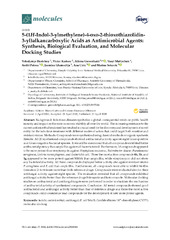Приказ основних података о документу
5-(1H-Indol-3-ylmethylene)-4-oxo-2-thioxothiazolidin-3-yl)alkancarboxylic Acids as Antimicrobial Agents: Synthesis, Biological Evaluation, and Molecular Docking Studies
| dc.creator | Horishny, Volodymyr | |
| dc.creator | Kartsev, Victor | |
| dc.creator | Geronikaki, Athina | |
| dc.creator | Matiychuk, Vasyl | |
| dc.creator | Petrou, Anthi | |
| dc.creator | Glamočlija, Jasmina | |
| dc.creator | Ćirić, Ana | |
| dc.creator | Soković, Marina | |
| dc.date.accessioned | 2020-05-08T10:39:30Z | |
| dc.date.available | 2020-05-08T10:39:30Z | |
| dc.date.issued | 2020 | |
| dc.identifier.issn | 1420-3049 | |
| dc.identifier.uri | https://www.mdpi.com/1420-3049/25/8/1964 | |
| dc.identifier.uri | https://radar.ibiss.bg.ac.rs/handle/123456789/3661 | |
| dc.description.abstract | Background: Infectious diseases symbolize a global consequential strain on public health security and impact on the socio-economic stability all over the world. The increasing resistance to the current antimicrobial treatment has resulted in crucial need for the discovery and development of novel entity for the infectious treatment with different modes of action that could target both sensitive and resistant strains. Methods: Compounds were synthesized using classical methods of organic synthesis. Results: All 20 synthesized compounds showed antibacterial activity against eight Gram-positive and Gram-negative bacterial species. It should be mentioned that all compounds exhibited better antibacterial potency than ampicillin against all bacteria tested. Furthermore, 18 compounds appeared to be more potent than streptomycin against Staphylococcus aureus, Enterobacter cloacae, Pseudomonas aeruginosa, Listeria monocytogenes, and Escherichia coli. Three the most active compounds 4h, 5b, and 5g appeared to be more potent against MRSA than ampicillin, while streptomycin did not show any bactericidal activity. All three compounds displayed better activity also against resistant strains P. aeruginosa and E. coli than ampicillin. Furthermore, all compounds were able to inhibit biofilm formation 2- to 4-times more than both reference drugs. Compounds were evaluated also for their antifungal activity against eight species. The evaluation revealed that all compounds exhibited antifungal activity better than the reference drugs bifonazole and ketoconazole. Molecular docking studies on antibacterial and antifungal targets were performed in order to elucidate the mechanism of antibacterial activity of synthesized compounds. Conclusion: All tested compounds showed good antibacterial and antifungal activity better than that of reference drugs and three the most active compounds could consider as lead compounds for the development of new more potent agents. | en |
| dc.publisher | MDPI AG | |
| dc.relation | info:eu-repo/grantAgreement/MESTD/inst-2020/200007/RS// | |
| dc.rights | openAccess | |
| dc.rights.uri | https://creativecommons.org/licenses/by/4.0/ | |
| dc.source | Molecules | |
| dc.subject | Antifungal | |
| dc.subject | Antimicrobial | |
| dc.subject | CYP51 | |
| dc.subject | Candida albicans 14α-demethylase | |
| dc.subject | E. coli MurB | |
| dc.subject | Indole | |
| dc.subject | Molecular docking | |
| dc.title | 5-(1H-Indol-3-ylmethylene)-4-oxo-2-thioxothiazolidin-3-yl)alkancarboxylic Acids as Antimicrobial Agents: Synthesis, Biological Evaluation, and Molecular Docking Studies | en |
| dc.type | article | en |
| dc.rights.license | BY | |
| dcterms.abstract | Героникаки, Aтхина; Картсев, Вицтор; Петроу, Aнтхи; Гламочлија, Јасмина; Ћирић, Aна; Соковић, Марина; Хорисхнy, Володyмyр; Матиyцхук, Васyл; | |
| dc.rights.holder | © 2020 by the authors. Licensee MDPI, Basel, Switzerland. | |
| dc.citation.issue | 8 | |
| dc.citation.volume | 25 | |
| dc.identifier.doi | 10.3390/molecules25081964 | |
| dc.identifier.pmid | 32340255 | |
| dc.identifier.scopus | 2-s2.0-85083806377 | |
| dc.identifier.wos | 000534617500090 | |
| dc.citation.apa | Horishny, V., Kartsev, V., Geronikaki, A., Matiychuk, V., Petrou, A., Glamoclija, J., et al. (2020). 5-(1H-Indol-3-ylmethylene)-4-oxo-2-thioxothiazolidin-3-yl)alkancarboxylic Acids as Antimicrobial Agents: Synthesis, Biological Evaluation, and Molecular Docking Studies. Molecules, 25(8), 1964. | |
| dc.citation.vancouver | Horishny V, Kartsev V, Geronikaki A, Matiychuk V, Petrou A, Glamoclija J, Ciric A, Sokovic M. 5-(1H-Indol-3-ylmethylene)-4-oxo-2-thioxothiazolidin-3-yl)alkancarboxylic Acids as Antimicrobial Agents: Synthesis, Biological Evaluation, and Molecular Docking Studies. Molecules. 2020;25(8):1964. | |
| dc.citation.spage | 1964 | |
| dc.type.version | publishedVersion | |
| dc.identifier.fulltext | https://radar.ibiss.bg.ac.rs/bitstream/id/6158/Molecules_2020_25_8_1964.pdf | |
| dc.citation.rank | M22 |

